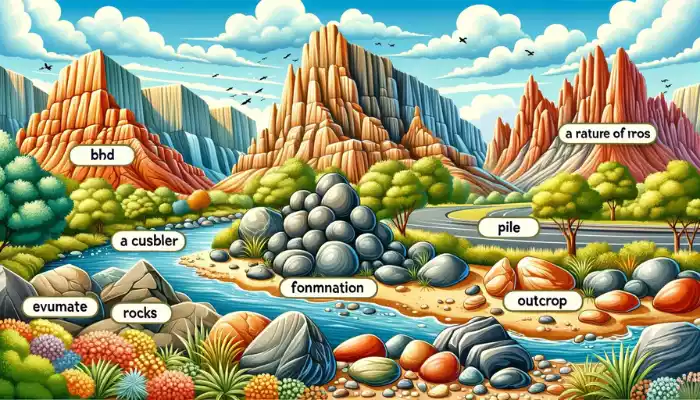Welcome to a fascinating journey through the language of geology today we are exploring the intriguing collective nouns used for rocks. Rocks those silent storytellers of Earths grand history come in various shapes sizes and compositions. But when we talk about them in groups what words do we use Let us find out together.
Collective Noun for Rocks
| Noun | Collective Noun | Definition | Example |
|---|---|---|---|
| Rocks | Bed | A large and compact collection of rock layers | A bed of limestone |
| Rocks | Cluster | A group of rocks found close together | A cluster of smooth river rocks |
| Rocks | Pile | A heap or stack of rocks placed on top of each other | A pile of rocks by the road |
| Rocks | Formation | A naturally occurring group of rocks with a specific shape or structure | The rock formation looked like a natural fortress |
| Rocks | Outcrop | A visible exposure of bedrock or ancient geological formations on the surface of the Earth | An outcrop of granite on the mountains face |
Detailed Explanations and Examples for Rocks
1. Bed
A bed of rocks refers to layers of rock that have formed over time, often seen in sedimentary rock formations. These layers can tell stories of Earth’s past environments.
- Example 1: In the canyon, we saw a bed of sandstone, layered beautifully by time.
- Example 2: Geologists study beds of shale to understand ancient climates.
- Example 3: The cliff showcased a striking bed of volcanic ash turned to stone.
2. Cluster
A cluster of rocks is a group found closely together, often by natural processes.
- Example 1: Near the stream, a cluster of smooth rocks glistened under the sun.
- Example 2: Children love to collect clusters of pebbles at the beach.
- Example 3: A cluster of meteorite fragments was found in the desert.
3. Pile
A pile of rocks is usually formed by human or natural actions, creating a heap.
- Example 1: Hikers marked the trail with a small pile of rocks.
- Example 2: After the landslide, a pile of rocks blocked the path.
- Example 3: Gardeners use piles of rocks to create natural-looking borders.
4. Formation
A rock formation is a significant and identifiable group of rocks that forms a notable natural structure.
- Example 1: The famous Stonehenge is an ancient rock formation.
- Example 2: The Grand Canyon is home to many breathtaking rock formations.
- Example 3: Photographers flock to capture the beauty of arch rock formations.
5. Outcrop
An outcrop occurs when bedrock or geological formations are exposed at the Earth’s surface.
- Example 1: The outcrop revealed layers of history, with fossils embedded in the rocks.
- Example 2: Climbers tackled the steep outcrop with enthusiasm.
- Example 3: The road was cut through a hill, revealing an outcrop of sparkling minerals.
Conclusion
Rocks in all their varied forms are more than just the solid foundation of our planet. They are the keepers of history telling tales of the Earths past that are waiting to be discovered. By learning about the collective nouns for rocks we not only expand our vocabulary but also deepen our appreciation for the natural world. Whether it’s a bed of ancient sedimentary rocks, a cluster of river stones a pile created by human hands a majestic rock formation or an exposed outcrop, each term invites us to explore and learn more about our planet’s geology.
Quiz Time: Test Your Knowledge!
1. What is the term used for a large and compact collection of rock layers?
- A) Cluster
- B) Pile
- C) Bed
- D) Outcrop
2. Which collective noun refers to a group of rocks found closely together?
- A) Formation
- B) Cluster
- C) Pile
- D) Bed
3. What do we call a naturally occurring group of rocks with a specific shape or structure?
- A) Cluster
- B) Pile
- C) Formation
- D) Outcrop
4. A visible exposure of bedrock or ancient geological formations on the Earth’s surface is known as a:
- A) Bed
- B) Cluster
- C) Outcrop
- D) Pile
5. A heap or stack of rocks placed on top of each other is called a:
- A) Formation
- B) Outcrop
- C) Bed
- D) Pile
Quiz Answers
- C) Bed
- B) Cluster
- C) Formation
- C) Outcrop
- D) Pile

